

The area of the mount Gunung Kidul, to a few tens of Kilometers only in the east of Yogyakarta, carries the traces of human presence going back to nearly 10 000 years. One finds there many archeological sites reporting this presence, as well as the remainders of some Candi now disappeared.
Located in the hamlet of
the same name, close to the village of Pacarejo, in the south of Wonosari, one
can see disseminated around a large tree, in undergrowth close to some houses,
of very many stones coming from a sanctuary, and also several pieces of small
statues.
This site is in the east
of Wonosari close to the village of the same name in the hamlet of Banteng,
called thus because of the sculpture of a cow (banteng) squatted which throne
in this very pretty hamlet, encircled by the cultivated fields, rice plantations,
and skirted by a broad river. There, on the hill dominating the river, and bellow
of a house, one can see many stones indisputably coming from one Candi.
Situs Ganang is in the hamlet of the same name close to the village of Ngawis in the west of Karangmojo. A panel shows the way to be followed.
The road ends finally in
a cul-de-sac at the foot of a small hillock. At the top of the hillock, masked
by walls, is a Moslem cemetery, and also a yoni in a neglected state,
that can be reached by a flight of steps.
On the other side of the
road after the cultivated fields, and on a weak hill strewn with some houses
of peasants, one can see a great number of stones, only remainders of sanctuaries,
and being used now as low retaining walls for the cultivated terraces.
If you go one day over there, you will be astonished by the very warm welcome by these poor peasants. They will offer the board and even the lodging if necessary to you.
The underground of the fields contains also many hidden statues. But the peasants said to me that it was forgiven to them to excavate the ground in order to extract these relics from another time.
This site is in the village of the same name, close to the road rejoining Karangmojo with Senin.
There too, and oddly, the
remainders of one Candi, in particular a yoni like a few pieces of small statues, are in a cemetery.
Near the site of Ganang, on a plateau with a rather surrealist landscape composed by enormous blocks of volcanic stone, with potatoes forms growing - if one can say - in the fields and the plantations of the peasants, are two archaeological museums in open air, Situs Sokoliman and Situs Gondang (traffic signs show the way to be followed to arrive to each one of these sites distant of approximately 500 m as crow flies, but 2 km by the road.
There, in a well arranged ground, one can see, perfectly aligned and lying on a ground of small stones, a very great number of stone cylinders as well as fine flagstones also.
No indication being provided, one wonders obviously the meaning of all this stones. Could it be remains of menhirs and dolmens, or is it lingga ? Why so many pieces? It is clearly however that these objects are extracted and faconnés starting from the enormous rocks which "grown" around. This is why, at the time, and by considering the number of these pillars, nearly a hundred per site, I initially thought of a "factory".
These cylinder of stones measure all about from 25 cm to 40 cm in diameter for variable lengths, some being broken, being able to exceed one meter and even reach 1,50 m. All that leaves somewhat circumspect because they resemble neither menhirs, which are generally blocks of stones inflated like an egg, and put in ground, upright, which is not the case here, nor with lingga, because the lingga presents a squared base and an octagonal end what is never the case here.
Concerning the flagstones, of rather fine plates from approximately 0,60 to 0,80 m wide for 1,20 to 1,50 m length, some are still putted in the ground and others are upright and fitted together in grooves and form a formwork. Moreover, in order to reinforce the stability of the formwork and to prevent its dislocation, these plates are maintained upright with large stone stakes, placed on both sides plate.
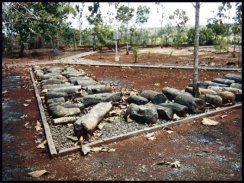
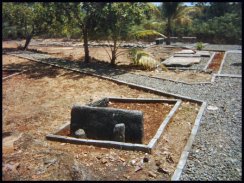
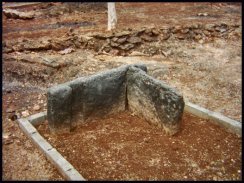
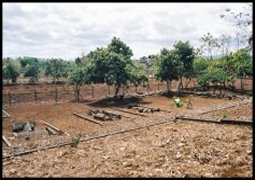
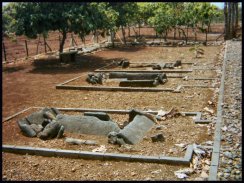
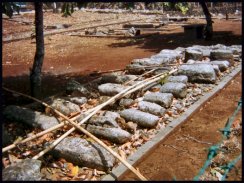
Such that these sites arise, it is quite difficult to say to what these stones were intended because, as I have already said, these cylinders resemble neither menhirs nor with lingga .
I perhaps found a possibility of answer to this question, after my return from Indonesia, in October 2003, by leaffing through a book finded in Pasar senen at Jakarta: Album of mégalithic tradition in Indonesia. A photograph, p. 125, taken in Rindi, island of Sumba, show us a large flat stone supported by large pillars. Under this flagstone and between the pillars, posed on the ground, is a stone sarcophagus (this type of sarcophagus is called "ciste" in French and "stone cist" in English), composed of four vertical flagstones laid out in rectangle, and covered by a flagstone a little larger. In this case, the work is monumental, since the feet of the large flagstone measure 2,15 m and the flagstones are in addition very thick, but one can have the same type of work with flagstones thinner.
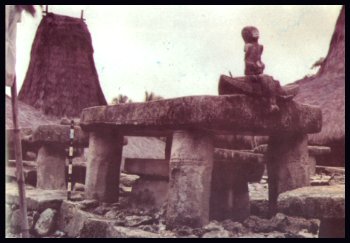
If the two sites (and there are perhaps others of them) of the area of Wonosari, have the same function, then Situs Sokoliman and Situs Gondang would be necropoles which would probably date from the first centuries of our era.
![]()